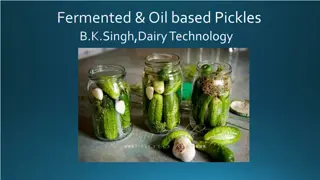
Benefits and Culinary Uses of Dill - Anethum graveolens
Discover the rich history and diverse uses of dill (Anethum graveolens) in cooking and traditional medicine. Learn about its various names, cultivation, and health benefits. Dill seeds and leaves are valued for their aromatic flavor and medicinal properties. Explore how dill is used in pickles, soups, sauces, and more. Available in various languages such as Hindi, Bengali, and Punjabi.
Download Presentation

Please find below an Image/Link to download the presentation.
The content on the website is provided AS IS for your information and personal use only. It may not be sold, licensed, or shared on other websites without obtaining consent from the author. If you encounter any issues during the download, it is possible that the publisher has removed the file from their server.
You are allowed to download the files provided on this website for personal or commercial use, subject to the condition that they are used lawfully. All files are the property of their respective owners.
The content on the website is provided AS IS for your information and personal use only. It may not be sold, licensed, or shared on other websites without obtaining consent from the author.
E N D
Presentation Transcript
DILL DILL -GODI SUSMITHA
DILL Scientific Name : Anethum graveolens L Family : Apiaceae/Umbelliferae English name: Dill, Garden Dill, Anet Indian name : Sowa, Soya (Hindi, Bengali, Punjabi and Urdu); Surva (Gujarati), Sabasige (Kannada), Soi (Kashmiri), Surva, Shepu (Marathi), Satapushpi (Sanskrit), Sathakuppi Sompa (Tamil), Sabasige (Telugu) Dill was known as a garden plant in ancient literature and the use of fruits as condiment was known since biblical times. Dill is of value for both its leaves and seeds. Leaves are also known as Dill weed , fresh or dried. When fresh, the leaves have a pleasant aromatic odour and warm taste. Dill seed with its pleasantly aromatic and warming flavor, laced by woody and menthol notes, is excellent for flavouring and seasoning. The genera Anethum, in which there are two species under cultivation, namely, The European dill, A.graveolens L. and another closely related Indian dill, A. sowa Roxb. ex Flem. Indian dill yields 1.2 to 4.0% volatile oil while European dill grown under Indian conditions yields 2.5 to 4.0% oil. The major constituent of seed oil is carvone (19.5 to 69.7%). Carvone content is the highest in European dill. The sowa herb yields 0.06% of essential oil, which has a higher proportion of terpenes (a-phellandrene), but no carvone. European dill herb oil contains both carvone and a-phellandrene. Badoc and Lamarti (1991) identified three broad chemotypes of European dill by the presence of carvone, and the presence or absence of myristicin and dillapiole.
Uses: Dill seeds are used, both whole and ground, as a condiment in soups, saiads, processed meats, sausages, spicy table sauces and in dill pickling. Dill stems and blossom heads are used for dill pickling and for flavouring soups. Grounds seed is an ingredient of seasoning. The green herb is used as a flavouring agent. Both seeds and oil (mainly) are used in the preparation of various indigenous medicines. The essential oil, dill oil or its emulsion in water (dill water) is considered to be an aromatic, carminative specially useful in control of flatulence, colic and hiccups in infants and children. The residue of the seed after the extraction of the volatile oil is reported to contain about 16.8 percent of fat and 15.1 percent of protein and can be used as cattle feed. The amount of component responsible for the aroma (hexahydrobenzofuran) in herbs varied between 4.5 and 7.5 mg/g DW. The essential oil is also used in the manufacture of soaps. Dill leaves are used for seasoning soups, salads, processed meats, sauces and particularly pickles. The seed is employed as a condiment in India and is also used as a carminative, aromatic stimulant and diuretic in Ayurvedic and Unani medicines. The emulsion of the seed oil in water is an important constituent of gripewater, useful in flatulence, colic pain, vomiting, diarrhoea and hiccups. The European dill seed oil is preferred in Pharmacy over the seed of the Indian dill or `sowa' due to the presence of a large percentage of dillopiole varying from 15.6 to 39.6% and a lower percentage of carvone in the sowa seed oil. Dillopiole is a toxic substance, not found in European dill seed oil. The dried residue left after the distillation of essential oil from seeds of A. graveolens contains fat-16.8% and protein-15.1%. This may be used as cattle feed
Origin and distribution Anethum graveolens is a native of the Orient and Mediterranean countries, and is found growing wild in Iran, Egypt, Abyssinia, various parts of Europe, Southern Russia, Africa and Asia. It is cultivated in the United States, Hungary, Germany, Holland, Sweden, Asia Minor, North Africa, India and England. In India, it has been successfully cultivated on an experimental scale in Jammu and Kashmir, Maharashtra, Gujarat, Andhra Pradesh, Madhya Pradesh and Rajasthan. Indian dill is a native of Northern India. Botany: Dill is a hepaxanthic annual or biennial aromatic herb, growing to a height of about 1 to 1.20 m. The leaves are feathery and stand on sheathing foot-stalks, with linear and pointed leaflets. The leaves are compound and light green in colour. The stem is smooth, shiny and hollow, having an upright growth and bearing flat terminal compound umbels, with numerous 31 yellow flowers, whose small petals are rolled inwards. The flowers are regular, bisexual, pentamerous and dichogamous. The fruits are flat, dry and groomed, commonly but erroneously these so-called seeds are produced in great quantities. They are very pungent and bitter in taste and are very light in weight. It consists of two brown, broadly oval, compressed, indehiscent, one-seeded carpels (mericarps), 3-4 mm long and 2-3 mm broad, with a thickness of 1.0 mm. They have five ridges, the three dorsal ridges being inconspicuous, brown, and the other two being lateral, yellowish and wing-like. The chromosome number is 2n=22. The seeds of the Indian dill are especially bold (large and good looking). They also tend to be longer and narrower in shape and their oil has a somewhat different profile
Climate Dill is quite a hardy plant and may thrive in much cooler climates, provided it finds a warm situation. It is a long day, cold weather crop, growing during the rabi season in the Indian plains. Strong winds and heavy rains during the flowering period may be injurious and extreme heat during maturity reduces the oil yield. Soil Dill grows well in any good garden soil with high fertility, sandy loam soils with good drainage being most suitable. Light sandy or heavy clay should be avoided. It can be successfully grown in soils with a pH upto 8.6. Varieties Haldwani selection and 'English stock' are the varieties recommended for cultivation in India. Among the foreign varieties, `Gribovskii' is recommended for early sowing, and high herbage and seed yield. A number of high yielding selections were identified in Indian dill. Of the selections, N.P. 127 and N.P. 179 were recommended for growing in the IndoGangetic plains, N.P. 115 for Gujarat and N.P. 15 for the hills. The average yield of these selections is around 1 to 14 t/ha
Cultivation Dill is propagated by seeds. The seeds are usually sown in March-April or in midOctober by drill or broadcast, in well- prepared land supplied with FYM @ 19 t/ha. The recommended seed rate is 3-5 kg/ha, sown in rows 60 cm apart and later thinned to a 30 cm 32 spacing after about 30 days from sowing when they are 13 cm high. The seeds have a viability of about three years and take 7-9 days for germination, when sown during the month of October, with 96 to 98% germination. If the crop is sown late, the vegetative phase is reduced, which seriously lowers the yield of the seed crop. A spacing of 45 x 20 cm and sowing in lines 30 or 45 cm apart have also been found suitable for this crop. Manures and fertilizers: The crop responds well to the application of nitrogenous and phosphatic fertilisers. A dose of 40-90 kg N and 40 kg P2O5 required for getting good crop and yield. 50 % N and entire P2O5 are applied at the time of sowing, the remaining 50 % N is top dressed 30 days after sowing.
Weeding and irrigation The plots should be kept free from weeds. Weedicides, Influtalin and Ethafluralin (1.1 kg/ha), Sethoxydim (4.5 kg/ha), Linuron (1 kg/ha), Chlorbromuron (4.5 kg/ha), Thiobencarb (6-8 kg/ha), etc., have been recommended for chemical weed control. Since it is a herbaceous crop, regular irrigation at an interval of about 8 to 12 days, depending on the soil and climatic conditions, is necessary. Generally, 8-9 irrigations are quite adequate for the maturity of the crop. Intercropping Dill can be intercropped with Rauwolfia serpentina or Mentha arvensis or Salvia sclara. Use of growth regulators Gibberellic acid (50 ppm) sprayed 15 days after emergence and again 10 days later, increases the yield and improves the flavour. Ascorbic acid (50 ppm) treatment is reported to yield oil with a high concentration of carvone and dihydroxycarvone and the lowest amount of dillapiole
Harvesting Harvesting should be done at proper stage and time, since the quality of oil depends upon the state of maturity of the herb and the fruits. The plants sown in mid-October will be ready for harvest by the end of April; i.e., the plants take about five and a half to six months for maturity. The main axis of the stem ends in a large-sized compound umbel, which is axillary in position, or in branches. The crop continues to produce umbels on the tertiary branches and these are at various stages of maturity, at harvest time for a seed crop. The crop is prone to shedding on maturity and, therefore, should be carefully collected at the right time of maturity. Generally, for obtaining dill oil, harvesting is done when the crop is about 31 /2 months old and is in the milky, ripening seed stage and the most advanced fruits are turning brown. After harvest, the plants are allowed to wilt in the field for 1-2 days and then distilled. When the crop is grown for its fruits, it is harvested when most of the fruits are fully developed (ripe), but still green in colour. The fruit at this stage contains maximum oil and carvone content and this procedure also avoids the shedding of seeds. To avoid shedding in very dry weather, harvesting is preferably done early in the morning, when the plants are still damp with overnight dew. The harvested material is dried in the field till the fruits can be easily threshed. The threshed fruits should be spread in a thin layer and frequently turned over until thoroughly dry. The seeds, after drying and cleaning, are packed in gunny bags and kept in a cool and dry place. Dill has a shelf-life of 6- 9 months.
Yield The herbage yield is about 2.5 to 3.0 t/ha, which on distillation gives about 18-20 kg of oil containing 30% of carvone, while the seed yield is about 5 to 7 q/ha. Distillation The essential oil is extracted by steam distillation from the herb, including the immature fruits and also from the mature and separated fruits. The two oils, however differ in composition, odour and flavour. The herb or 'weed' oil (isolated from the above-ground parts, including the unripe seeds) is preferred by the food industry, because of its more 34 characteristic dill herb flavour. The seed oil, with its high carvone content, resembles the oil of caraway. During recent years, dill-herb oil has largely replaced the fruit oil for flavouring and seasoning purposes. Value-added products The value-added products of dill are dill-seed powder, dill-seed oil, dill weed (dill leaves), oleoresin dill, etc.












